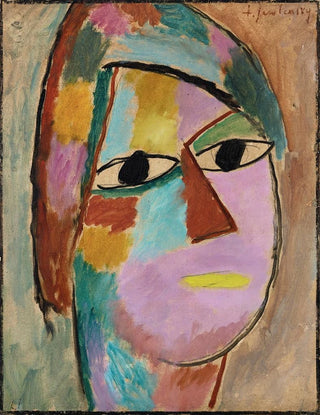Art print | Mystical head - Alexej von Jawlensky


View from behind

Frame (optional)
Art print Tête mystique - Alexej von Jawlensky – Introduction captivante
The "Tête mystique" by Alexej von Jawlensky is a piece that transcends a simple portrait to immerse the viewer in a spiritual and emotional experience. Painted in the early 20th century, this iconic work stands out for its innovative approach to the human face, revealing layers of psychological and spiritual complexity. Jawlensky, a major figure of the Expressionist movement, uses vibrant colors and simplified forms to evoke deep states of mind, inviting us to contemplate not only the external appearance but also the inner essence of his subject. This artwork, both enigmatic and captivating, embodies the artist's quest for a more authentic representation of the human soul.
Style and uniqueness of the work
The "Tête mystique" is characterized by its distinctive style, where the fusion of bold colors and stylized shapes creates an atmosphere that is both intimate and universal. Jawlensky chooses hues that seem to vibrate on the canvas, each shade contributing to the overall emotion conveyed by the depicted face. The contours are softened, almost blurred, giving the work a dreamlike quality. Moving away from realistic conventions, the artist manages to capture an essence that goes beyond mere representation. The eyes, often considered the windows to the soul, are here mirrors of deep feelings, engaging the viewer in a silent dialogue. This unique approach makes the "Tête mystique" a work of art that resonates with anyone seeking to explore the mysteries of identity and spirituality.
The artist and his influence
Alexej von Jawlensky, born in Russia and naturalized German, played a crucial role in the development of Expressionism. Trained at the Saint Petersburg Academy of Fine Arts, he draws inspiration from Eastern and Western traditions, while incorporating elements of spirituality. His encounters with other artists, such as Wassily Kandinsky and Franz Marc, allowed him to immerse himself in a fertile creative environment where innovative ideas about color and form come to life. Jawlensky,

Matte finish

View from behind

Frame (optional)
Art print Tête mystique - Alexej von Jawlensky – Introduction captivante
The "Tête mystique" by Alexej von Jawlensky is a piece that transcends a simple portrait to immerse the viewer in a spiritual and emotional experience. Painted in the early 20th century, this iconic work stands out for its innovative approach to the human face, revealing layers of psychological and spiritual complexity. Jawlensky, a major figure of the Expressionist movement, uses vibrant colors and simplified forms to evoke deep states of mind, inviting us to contemplate not only the external appearance but also the inner essence of his subject. This artwork, both enigmatic and captivating, embodies the artist's quest for a more authentic representation of the human soul.
Style and uniqueness of the work
The "Tête mystique" is characterized by its distinctive style, where the fusion of bold colors and stylized shapes creates an atmosphere that is both intimate and universal. Jawlensky chooses hues that seem to vibrate on the canvas, each shade contributing to the overall emotion conveyed by the depicted face. The contours are softened, almost blurred, giving the work a dreamlike quality. Moving away from realistic conventions, the artist manages to capture an essence that goes beyond mere representation. The eyes, often considered the windows to the soul, are here mirrors of deep feelings, engaging the viewer in a silent dialogue. This unique approach makes the "Tête mystique" a work of art that resonates with anyone seeking to explore the mysteries of identity and spirituality.
The artist and his influence
Alexej von Jawlensky, born in Russia and naturalized German, played a crucial role in the development of Expressionism. Trained at the Saint Petersburg Academy of Fine Arts, he draws inspiration from Eastern and Western traditions, while incorporating elements of spirituality. His encounters with other artists, such as Wassily Kandinsky and Franz Marc, allowed him to immerse himself in a fertile creative environment where innovative ideas about color and form come to life. Jawlensky,






